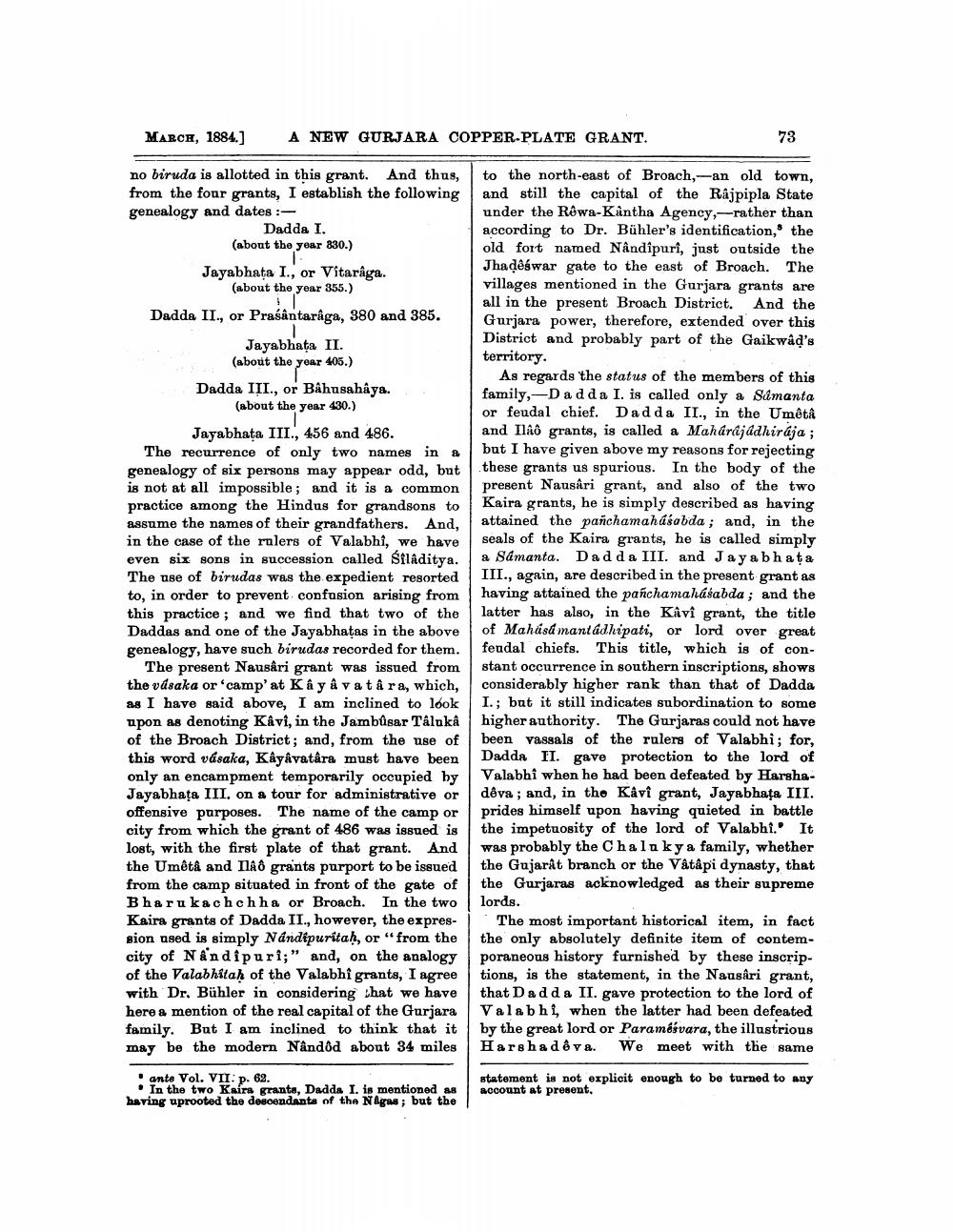________________
MARCH, 1884.)
A NEW GURJARA COPPER-PLATE GRANT.
73
no biruda is allotted in this grant. And thus, from the four grants, I establish the following genealogy and dates :
Dadda I. (about the year 830.) Jayabhata I., or Vitaraga.
(about the year 355.) Dadda II., or Praśântarâga, 380 and 385.
Jayabhata II.
(about the year 405.) Dadda III., or Bahusahaya.
(about the year 430.) Jayabhata III., 456 and 486. The recurrence of only two names in a genealogy of six persons may appear odd, but is not at all impossible; and it is a common practice among the Hindus for grandsons to assume the names of their grandfathers. And, in the case of the rulers of Valabhî, we have even six sons in succession called Siladitya. The use of birudas was the expedient resorted to, in order to prevent confusion arising from this practice; and we find that two of the Daddas and one of the Jayabhatas in the above genealogy, have such birudas recorded for them.
The present Nausâri grant was issued from the vdsaka or camp'at Kay à va tara, which, as I have said above, I am inclined to look upon as denoting Kåvi, in the Jambúsar Taluka of the Broach District; and, from the use of this word vásaka, Kåyåvatâra must have been only an encampment temporarily occupied by Jayabhata III. on a tour for administrative or offensive purposes. The name of the camp or city from which the grant of 486 was issued is lost, with the first plate of that grant. And the Umêta and nað grants purport to be issued from the camp situated in front of the gate of Bharu kachchha or Broach. In the two Kaira grants of Dadda II., however, the expression used is simply Nandipuritah, or “from the city of Nandipuri;” and, on the analogy of the Valabhitaḥ of the Valabhi grants, I agree with Dr. Bühler in considering that we have here a mention of the real capital of the Gurjara family. But I am inclined to think that it may be the modern Nândod about 34 miles
to the north-east of Broach,-an old town, and still the capital of the Rajpipla State under the Rowa-Kantha Agency,--rather than according to Dr. Bühler's identification, the old fort named Nandipuri, just outside the Jhadeswar gate to the east of Broach. The villages mentioned in the Gurjara grants are all in the present Broach District. And the Gurjara power, therefore, extended over this District and probably part of the Gaikwad's territory.
As regards the status of the members of this family,-Dadda I. is called only a Samanta or feudal chief. Dadda II., in the Umêtå and Ilâð grants, is called a Maharajadhiraja ; but I have given above my reasons for rejecting these grants us spurious. In the body of the present Nausâri grant, and also of the two Kaira grants, he is simply described as having attained the pañchamahúsabda; and, in the seals of the Kaira grants, he is called simply a samanta. Dadda III. and Jay a bhata III., again, are described in the present grant as having attained the panchamahasabda; and the latter has also, in the Kavi grant, the title of Mahásd mantadhipati, or lord over great feudal chiefs. This title, which is of constant occurrence in southern inscriptions, shows considerably higher rank than that of Dadda I.; but it still indicates subordination to some higher authority. The Gurjaras could not have been vassals of the rulers of Valabhi; for, Dadda II. gave protection to the lord of Valabhî when he had been defeated by Harshadeva; and, in the Kåvi grant, Jayabhata III. prides himself upon having quieted in battle the impetuosity of the lord of Valabhi. It was probably the Chalaky a family, whether the Gujarat branch or the Vatâpi dynasty, that the Gurjaras acknowledged as their supreme lords.
The most important historical item, in fact the only absolutely definite item of contemporaneous history furnished by these inscriptions, is the statement, in the Nausâri grant, that Dadda II. gave protection to the lord of Valabhi, when the latter had been defeated by the great lord or Paramésvara, the illustrious Harshadê va. We meet with the same
ante Vol. VII: p. 62. • In the two Kaira grants, Dadda I. is mentioned as having uprooted the descendants of the Nagas; but the
statement is not explicit enough to be turned to any account at present,




